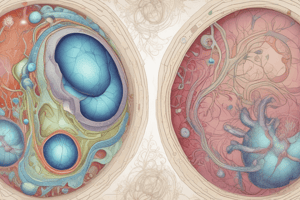Podcast
Questions and Answers
Neural crest cells differentiate from which particular germ layer?
Neural crest cells differentiate from which particular germ layer?
- Mesoderm
- Endoderm
- Ectoderm (correct)
- Neuroectoderm
What do these organelles describe: membranes appearing as profusely anastomosing tubules; abundant in cells that synthesize steroids?
What do these organelles describe: membranes appearing as profusely anastomosing tubules; abundant in cells that synthesize steroids?
- Smooth endoplasmic reticulum (correct)
- Centrioles
- Rough endoplasmic reticulum
- Lysosomes
What is a zygote?
What is a zygote?
single cell
Which facial processes merge to form the philtrum of the upper lip?
Which facial processes merge to form the philtrum of the upper lip?
Following migration, neural crest cells do NOT differentiate into which of the following?
Following migration, neural crest cells do NOT differentiate into which of the following?
At around day eight of ___ , the cells of the embryoblast will differentiate into the ___.
At around day eight of ___ , the cells of the embryoblast will differentiate into the ___.
Which statement does NOT refer to developmental processes in the embryo during the embryonic period?
Which statement does NOT refer to developmental processes in the embryo during the embryonic period?
Which layer of the blastocyst gives rise to the future embryo?
Which layer of the blastocyst gives rise to the future embryo?
Which structures arise from the lateral nasal processes?
Which structures arise from the lateral nasal processes?
Which statement about the fetal period is NOT true?
Which statement about the fetal period is NOT true?
A cleft along the left lacrimal area of the face ran along the sides of the nose and into the left side of the lip is due to the failure of which processes to fuse?
A cleft along the left lacrimal area of the face ran along the sides of the nose and into the left side of the lip is due to the failure of which processes to fuse?
After fertilization, human development will involve a phase of rapid ___ and migration of cells that will lead to the formation of a solid ball of cells known as the ___ .
After fertilization, human development will involve a phase of rapid ___ and migration of cells that will lead to the formation of a solid ball of cells known as the ___ .
What organelles transform chemical energy of metabolites into readily available energy of the cell?
What organelles transform chemical energy of metabolites into readily available energy of the cell?
The body of the tongue is primarily formed by which structure?
The body of the tongue is primarily formed by which structure?
Which future nerves and muscles are derived from the mandibular processes?
Which future nerves and muscles are derived from the mandibular processes?
Which statement about the fetal mandible is correct?
Which statement about the fetal mandible is correct?
Which of the following statements refer to the developmental processes that occur in the embryo during the embryonic period?
Which of the following statements refer to the developmental processes that occur in the embryo during the embryonic period?
During the development of the tongue, which structure will be incorporated into its structure?
During the development of the tongue, which structure will be incorporated into its structure?
The palatal shelves or the palatine processes, which form the secondary palate, develop in which direction during which week?
The palatal shelves or the palatine processes, which form the secondary palate, develop in which direction during which week?
Which facial primordia did NOT fuse completely, resulting in a right unilateral cleft lip?
Which facial primordia did NOT fuse completely, resulting in a right unilateral cleft lip?
The following structures are derived from the neural crest cells: 1. Branchial arch arteries, 2. Branchial arch cartilages, 3. Branchiomeric nerves, 4. Dental papilla. Which are correct?
The following structures are derived from the neural crest cells: 1. Branchial arch arteries, 2. Branchial arch cartilages, 3. Branchiomeric nerves, 4. Dental papilla. Which are correct?
What is the oropharyngeal or buccopharyngeal membrane composed of?
What is the oropharyngeal or buccopharyngeal membrane composed of?
What organelles are described as membrane bound and vesicle shaped, containing a variety of lytic enzymes?
What organelles are described as membrane bound and vesicle shaped, containing a variety of lytic enzymes?
Which adult structure does NOT form from the mesoderm?
Which adult structure does NOT form from the mesoderm?
Flashcards are hidden until you start studying
Study Notes
Germ Layers and Development
- Neural crest cells derive from the ectoderm germ layer, crucial for various developmental processes.
- A zygote is the single cell product of fertilization, leading to embryonic development.
- The primary palate separates the nasal cavity from the oral cavity, arising from facial processes like:
- Maxillary processes
- Medial nasal processes
Cell Organelles Identification
- The rough endoplasmic reticulum has ribosomes attached for protein synthesis.
- The smooth endoplasmic reticulum is abundant in steroid-synthesizing cells.
- Lysosomes contain lytic enzymes for digestion and waste processing.
- Centrioles are cylindrical structures involved in microtubule organization during mitosis.
Embryonic Development Stages
- Around day eight, the embryoblast differentiates into two cell populations during the formation of the blastocyst.
- The period of gastrulation during the third week establishes three embryonic layers:
- Ectoderm (outer layer)
- Mesoderm (middle layer)
- Endoderm (inner layer)
Developmental Processes
- Embryonic period involves:
- Cellular interactions and controlled growth
- Transformation of identical cells into distinct structures and functions
- The trophoblast and embryoblast will give rise to the future embryo, important for implantation and early development.
Fetal Development
- Fetal period is marked by:
- Maturation of existing structures without a dramatic change in organs' function.
- Physiological maturation of tissues and organs.
- The endoderm develops into the foregut, midgut, and hindgut structures.
Facial Structure Development
- Abnormal fusion of facial primordia can lead to conditions such as cleft lip, resulting from failure of maxillary and medial nasal processes to fuse.
- The philtrum of the upper lip is formed from the merging of maxillary and medial nasal processes.
Tongue and Mandible Development
- The body of the tongue is primarily formed by the lateral lingual swellings.
- The fetal mandible develops lateral to Meckel's cartilage and undergoes ossification.
Organelles and Function
- Mitochondria are organelles that transform chemical energy into usable energy for cells.
- Lysosomes contain enzymes for cellular digestion and waste removal.
Miscellaneous
- Melanin is not derived from the mesoderm; it originates from ectodermal cells, specifically melanocytes.
- The oropharyngeal membrane consists of ectoderm and endoderm, marking a critical phase in the formation of the digestive tract.
Key Terms
- Gastrulation
- Embryoblast
- Trophoblast
- Mesoderm, Ectoderm, Endoderm
- Lateral nasal processes
- Maxillary processes
These notes emphasize essential concepts of embryology and cell biology, key for understanding human development.
Studying That Suits You
Use AI to generate personalized quizzes and flashcards to suit your learning preferences.




